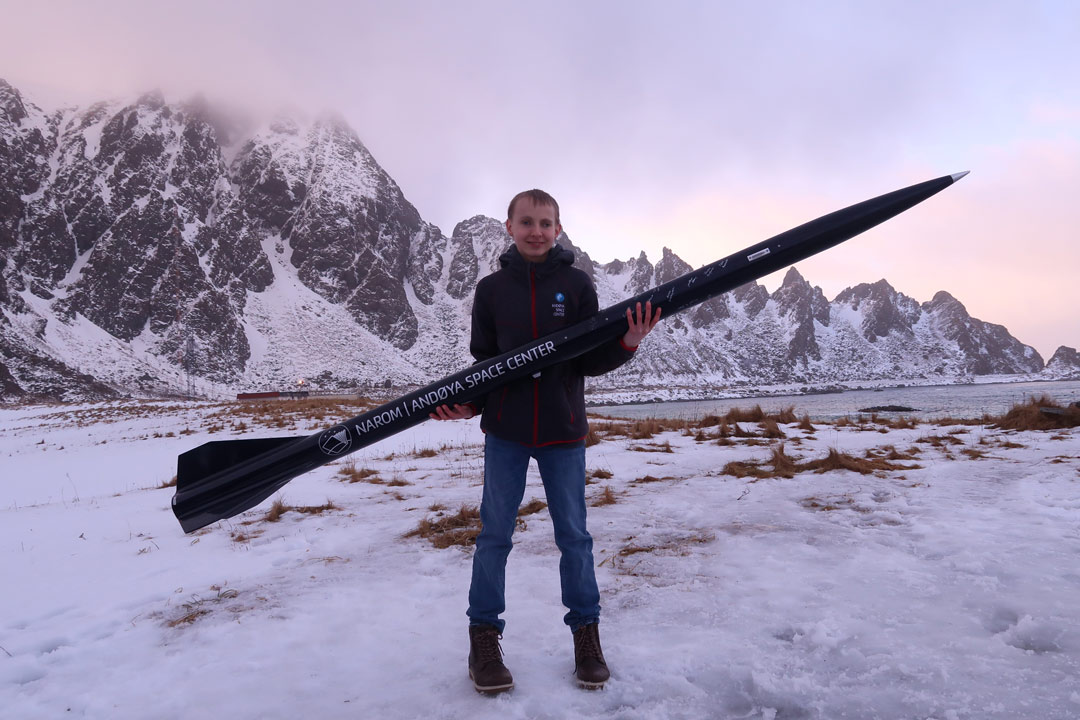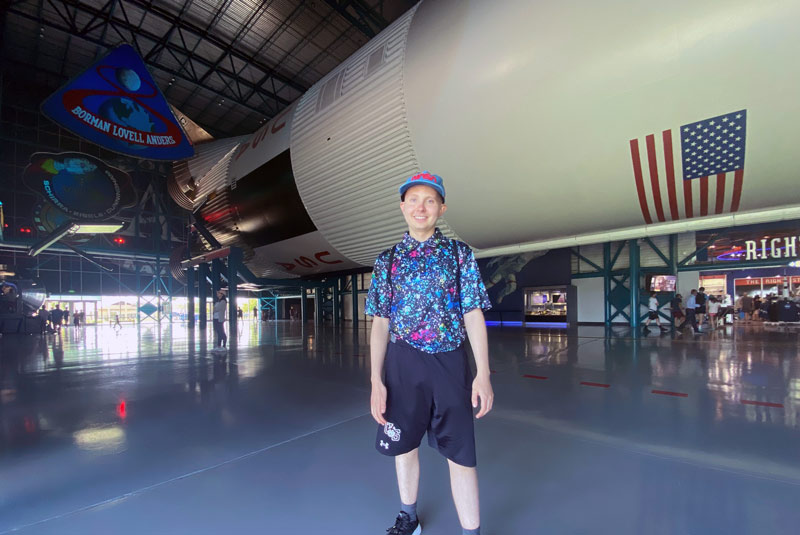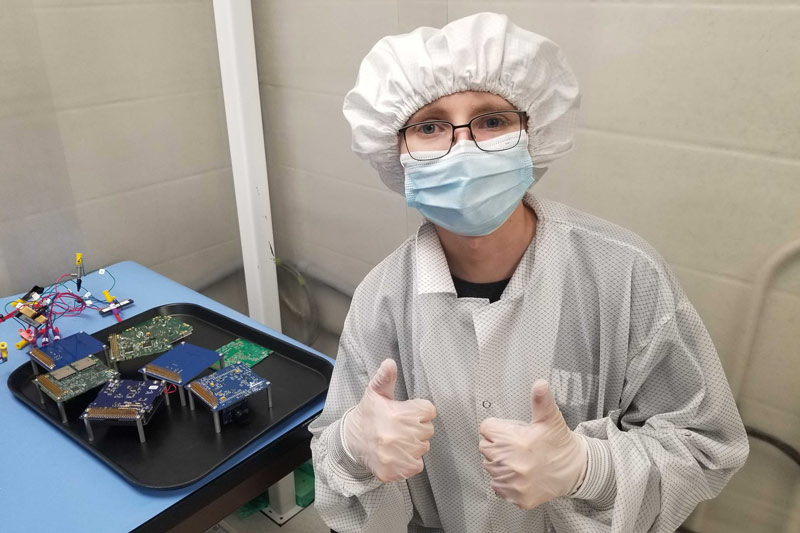
New USask graduate set out to do the impossible
Dylan Haussecker was told he couldn’t learn middle school math. He helped send a satellite into space.
By Chris PutnamFifteen times a day, Dylan Haussecker could look to the sky and know his work was flying above his head at a speed of almost eight kilometres per second.
Haussecker, who is graduating from the University of Saskatchewan (USask) this spring with degrees in electrical engineering and computer science, was a core member of the student team that designed and built the first made-in-Saskatchewan satellite in space.
“You don’t think you’ll get this opportunity as an undergraduate student. It means a lot to work on actual technology and work with actual industries that are changing the world. It's crazy cool,” said Haussecker.
Receiving his degrees will be extra special because the 24-year-old was never supposed to make it this far. At age 11, he was diagnosed with brain cancer and was warned the treatment would limit his ability to learn complex math and science.
“They were telling me in Grade 6, ‘You cannot do Grade 6 math.’ And I’m like, ‘I’m gonna prove them wrong. I’m gonna do engineering, because that sounds very difficult,’” said Haussecker, who is from Watson, Sask.
Haussecker’s cancer went into remission in 2012. By the time he was a teenager, he was winning science fairs and working with his dad to build and launch rockets as tall as himself. At university, he tutored other students in math and engineering.
In June 2023, he was invited with a handful of other USask students to a restricted area of NASA’s Kennedy Space Center in Florida to watch the satellite they had worked on for five years be launched aboard a SpaceX Falcon 9 rocket.
“We were only like a kilometer away from where the rocket actually launched. You could hear the rumbling and everything was shaking around you. It was intense and very crazy to think the satellite you worked on is in that rocket,” he said.
It was a dream come true for Haussecker, but it wasn’t the best experience of his life. The best experience was in February 2020 when he took part in CaNoRock, an international rocket science exchange program offered through the Department of Physics and Engineering Physics.

In just one week, Haussecker and a team of students from around the world designed, built and launched an eight-foot-tall rocket from the Andøya Space Center in Norway to a height of 50,000 feet.
“There are people from different universities of different backgrounds and you're all working together to a common goal—to launch this rocket—while also being in Norway in the mountains,” Haussecker said. “We got to run into the ocean in a snowstorm while the Northern Lights were over our heads. It was so cool.”
Haussecker took his first year of USask engineering at St. Peter’s College, an affiliated college in Muenster, Sask. When he arrived at the main USask campus for his second year of studies in 2018, he heard about a brand-new cube satellite project that involved the University of Saskatchewan Space Design Team (USST). He immediately signed up.
The project, titled RADSAT-SK, was a partnership between the Canadian Space Agency (CSA), the USST, the College of Engineering and Saskatchewan Polytechnic. Under the supervision of College of Engineering faculty member Dr. Sean Maw (PhD), the USST students were to design and build a miniature satellite about the size of a tissue box and see it launched on a resupply mission to the International Space Station (ISS).
Haussecker took on multiple roles during the five years of the project, contributing to the electrical and software systems and spending two years as one of the team’s three project managers. More than 100 USask students eventually worked on RADSAT-SK.
During this time, Haussecker began taking classes toward a three-year computer science degree in the College of Arts and Science. He knew the degree would be a good supplement to his electrical engineering degree, and the skills he learned were quickly put to use when programming the cube satellite.
The team’s work had to meet tight deadlines and pass multiple design reviews with the CSA to ensure it met all requirements to go into space. When RADSAT-SK was finally unloaded onto the ISS and shot into its own orbit from the station’s onboard cube satellite launcher, the team’s work wasn’t over. They built a ground station on campus to communicate with the satellite and receive data from the experiments onboard.

After about seven months in orbit, the satellite re-entered Earth’s atmosphere on schedule and burned up early this year. The USask team was never able to establish contact with RADSAT-SK, but Haussecker wasn’t discouraged.
“The important thing is it went to space, and that’s never been done before,” he said.
Since the cube satellite project wrapped up, Haussecker has been advising on the construction of RADSAT-SK2, a second satellite currently being built by the USST. He also spent more than two years as avionics lead of a USST project to build a large rocket that the team plans to launch at a national competition this summer.
Haussecker and a small group of USask students and alumni are currently developing a new business with help from the College of Engineering’s SIGMA entrepreneurship program. Using lessons learned from the long days and nights spent testing the cube satellite, the group is building hardware and software solutions to help engineers reduce the risk of damaging expensive electronics when testing designs.
That business might take off after Haussecker graduates, or he might look into jobs in the space or mining industries. After beating brain cancer, nothing seems out of reach.
“(Something like that) makes you want to tackle the hardest problems in life. That was a very hard problem to tackle. And then you realize that you just have to take a few steps and you can solve pretty much anything,” Haussecker said.
Together, we will undertake the research the world needs. We invite you to join by supporting critical research at USask.
Article re-posted on .
View original article.

